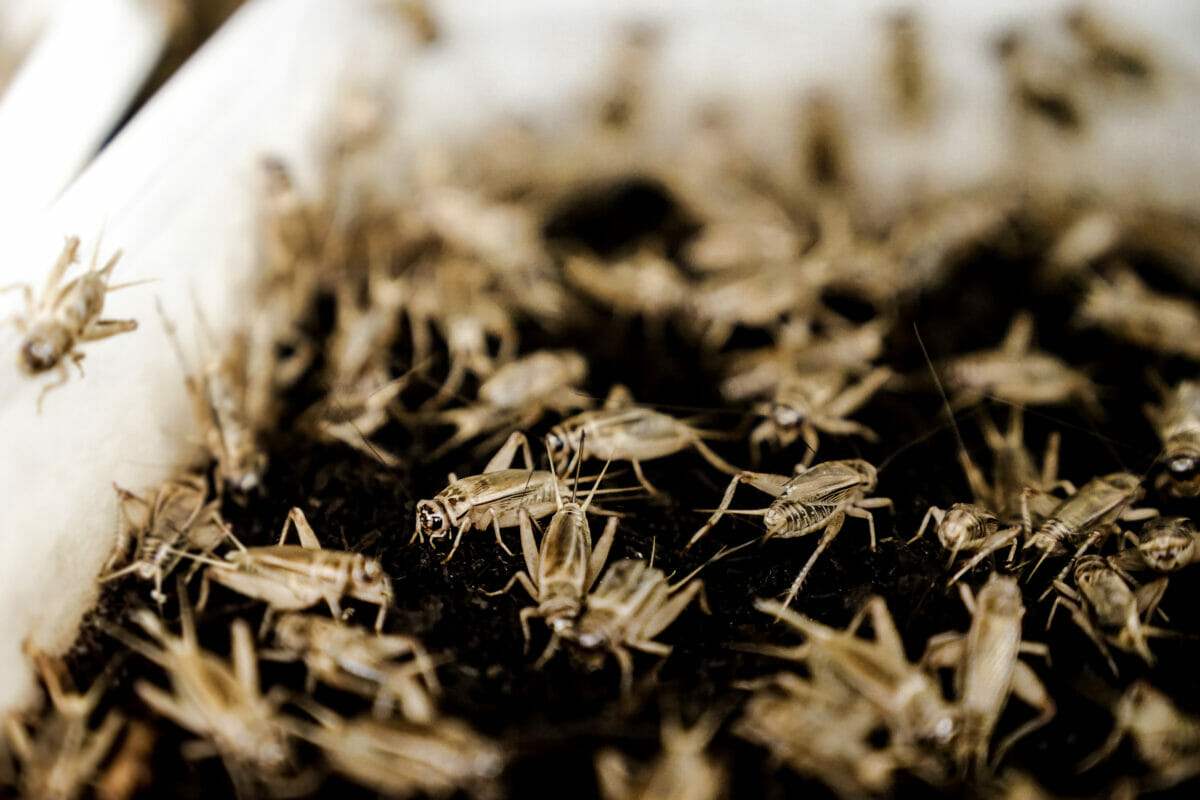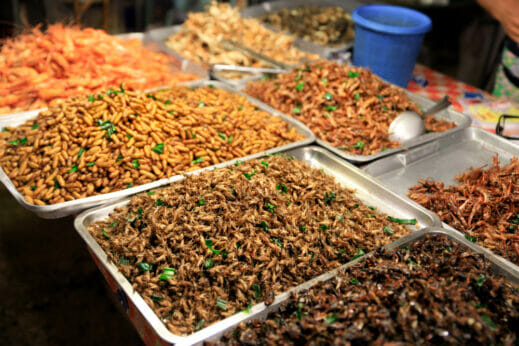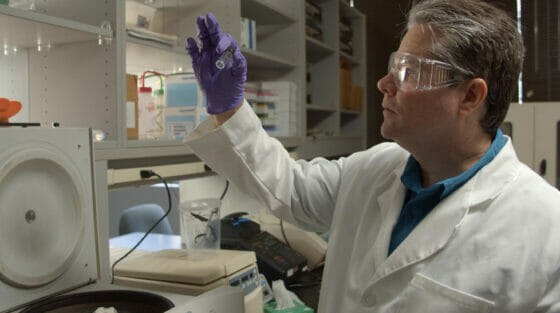Entomophagy, or the consumption of insects, is gaining interest in North America and the European Union, where it’s seen as a replacement for animal protein and a weapon in the fight against climate change.

When Mohammed Ashour walks into Aspire Food Group’s 150,000 square-foot cricket farm in London, Ontario, he is met with a symphony of chirping—for most people the sound of languid lakeside summers. For Ashour, Aspire’s co-founder and CEO, the tonal chirping of his Acheta domesticus crickets is the music of commerce, as well as the soundtrack of the future. “It’s soothing,” Ashour says simply.
Only sexually mature males chirp, and these are the ones that will sire billions more crickets that, 28 days after being hatched from an egg, will be frozen and sold as a source of protein for humans and pets. Currently accepted as a novelty food or a protein in pet food, insect consumption is being touted as a critical cog in the battle against climate change, as well as a solution to global malnutrition. Picky Western consumers have a problem, though: A meal of arthropods instead of steak and burgers is a gastronomic leap.
A climate-friendly food
The global population is estimated to reach nearly 10 billion by 2050, with the demand for animal protein expected to rise commensurately. This will put untold pressure on a planet already reeling from biodiversity loss, with vast tracts of forest being converted into grazing land for livestock, which produces 32 percent of all methane emissions. Meeting the nutritional needs of a burgeoning population means that food production will have to increase by 70 percent, leading to further dire environmental consequences, including a 30-percent growth in greenhouse gases.
In comparison, edible insects such as mealworms create less than one percent of the amount of greenhouse gases that cows do; house crickets even less. Statista reports that insect cultivation requires two percent of the amount of water required by cattle. Insects also require significantly less space than cattle, hogs or poultry.
Insects are an ancient source of protein and consumable at any stage of their life cycle: eggs, larvae, pupae or adults. The Food and Agriculture Organization of the United Nations (FAO) states that there are about 2,000 edible insect species globally. The most common are crickets, grasshoppers, caterpillars, bees, beetles, wasps and locusts, currently enjoyed by about two billion people.

Fried insects, including locusts and crickets, at a vendor stall in Thailand. (Ben Petcharapiracht/Shutterstock)
An appetite for change
In the West, insects are generally viewed as pests that consume crops and carry disease, adding to the prevailing “ick” factor. Yet, consumers are slowly becoming aware of insects’ superior nutritional values: vitamin- and mineral-rich, packed with protein, fibre, omega fats and iron while being low in fat and calories. Such nutritional selling points are bolstered by an increasing number of insect cookbooks, insect cooking classes, online recipes and insect entrees offered by daring high-end restaurants.
Embracing entomophagy isn’t an all-or-nothing proposition. “If a family of four got their protein from insects one day a week for over a year, they would save about 750,000 liters of water,” says Dr. Jarrod Goldin, co-founder of Entomo Farms, which produces crickets in its 60,000-square-foot Norwood, Ontario facility. “Cows only convert 10 percent of their feed into food we can eat, while crickets convert close to 100 percent,” says Goldin, who also sells frass, or cricket manure, as fertilizer to large retailers.
U.S.-based Future Market Insights (FMI) reports that the insect protein market is expected to reach $838.5 million in 2032, up from $349.2 million in 2022. Much of the growth will occur in the European food and beverages sector. This may well be accelerated by legislation, passed by the European Union in January, approving the sale of insects for human consumption in powder and other dried forms, creating new markets for companies such as Aspire Foods and Entomo Farms.
The International Platform of Insects for Food and Feed (IPIFF) anticipates rapid growth of insect-based food products, forecasting an increase to 260,000 tonnes by 2030 from a current production of only a few thousand tonnes, says IPIFF communications manager Alice Grassi. Although one-quarter of current insect consumption in Europe is whole insects, growth will most likely happen with items such as meat-like products and baked goods, says Grassi.

The billions of crickets housed in Aspire Food Group’s 150,000 square-foot facility are harvested after 28 days for human and pet consumption.
Snack foods and beyond
Gabrielle Wittock of Brussels is an entrepreneur intent on growing the edible-insect market. When Wittock’s Yuma cricket crackers first hit EU food stores in June 2020, she thought it might be a challenge convincing consumers to try a product containing bugs. She was pleasantly surprised when sales doubled year over year.
The snacks, combining the nutty taste of crickets with savoury flavours such as rosemary and pumpkin seed, are the opening salvo to Wittock’s “mission to familiarize people with eating insects.” In two years’ time, she says, Europeans will be used to insect-based products, making the market ripe for the Yuma burger, a forthcoming patty containing 20 percent mealworms mixed with vegetable ingredients. “When they are confident in our brand, they will dare to try the burgers,” says Wittock, noting that mealworms have a more subtle taste than crickets.

Gabrielle Wittock of Brussels sells Yuma cricket crackers that are infused with flavours like rosemary and pumpkin seed.
The main hurdle to insect consumption is psychological, says Wittock. Foods such as pasta and meat are symbolic, representative of both culture and religion. Snack foods such as crackers have less symbolism and are thus more readily embraced.
Oklahoma-based molecular biologist Dr. Aaron Dossey, founder of the biotechnology company All Things Bugs, also supplies and sells edible crickets. Dossey retails cricket powder Griopro made from insects sourced from Armstrong’s Cricket Farm in Louisiana. He sells cricket powder wholesale to companies producing protein snack bars, cookies, chips and pet snacks. Dossey, however, is most excited about insects’ pharmaceutical potential.
Insects are “a little nugget of biological material that we’ve never looked at before,” says Dossey, who runs a private research lab at University Research Park in Oklahoma. Genetic engineering offers the potential for new drugs, vaccines, antibiotics, insect repellents and plastics, among many other possible uses, says Dossey, who is also researching how to increase insects’ nutritional content and resistance to disease.

Molecular biologist Dr. Aaron Dossey of Oklahoma is researching new uses for insects, from vaccines to antibiotics and replacement materials for plastics.
Will insects inherit the Earth? They will if edible-insect entrepreneurs and innovators have anything to do with it. Ashour, for example, has plans to build automated cricket farms on the grounds of insect-product producers, ensuring they have access to a constant supply of raw material. This would eliminate long-distance transportation and lessen the environmental footprint while making insect products increasingly competitive.
Ashour warns that future consumer embrace of arthropod cuisine is dependent upon flavour. “People eat steak because it tastes so damn good,” says Ashour. Entomophagy will have to be an equally delightful and memorable experience. “While I don’t think that steak consumption is going to go away, I do think that we can live in a world that is balanced with nature. That’s the vision we want to inspire.”
Correction, Feb. 27, 2023: An earlier version of this article attributed the insect protein market report to The Food Industry Association (FMI). That information came from Future Market Insights (FMI).
Re Insect Protein…all the Spin Doctors talk about their Crickets and Meal Worms being more sustainable than Beef, Pork or Poultry …how can it be when they are feeding their insects on the very food they accuse us commercial farmers of growing and destroying the planet. I’m referring to Maize and Soya Meal as well as Wheat Bran, 3 crops they ALL feed their insects on! What Hypocrisy, not to mention that they are liars!!! They are NOT using any less land than us cattle farmers use or don’t they take the crops they feed their insects into consideration when… Read more »
This is the most idiotic thing that could ever happen…believing that we are battling against climate change but in realization, they are literally destroying…people tend to believe this delusional dilemma that has but implemented in their brains without actually knowing where their hiding…people are being deceived more than ever and for free:”) this has never happened throughout history and it has been said in the Revelation book that many nations shall be deceived and many will be blinded in lovers of this world by flesh and it also mentioned that many things will occur that have never happened before and… Read more »
What total nonsense! There is nothing more earth and climate friendly than ruminants on pasture in a rotational grazing system, as opposed to tilling soil to monocrop corn and soy for any purpose. Pushing the consumption of bugs rather than pastured meat is just a way of controlling people by controlling the food supply.
This article is chock full of falsehoods & marketing propaganda aimed at people who are not farmers. Real facts matter when assessing anything. Poor areas in third world countries often don’t have a choice but to eat insects and can’t afford more. It’s a famine food. I’m sure most would quickly drop those for better meat choices. Secondly, these types of propaganda pushers always pick on cows (so I will focus on cows), farting & burping. Its a war on cows, with blatant misinformation (lies) as its base & meant to deceive. If every media source repeats something often enough,… Read more »
I think soylent green would be a better option if we’re looking for an apocolyptic scenario – just what the powers that be would like to impose on their slaves while they continue to consume steak and champagne
take the blinders off many eyes we pray
“You will eat bugs, own nothing, and be happy.” Guess again. The people pushing this are the World Economic Forum and those pushing ‘climate change’. Don’t believe anything those people say. Remember when everyone said we were heading for another Ice Age. That didn’t happen, either. Let the people pushing the eating of bugs eat the bugs, I shall never eat bugs. Period.
I’ve tried flavored chips (Chirps Chips) made from cricket flour.
They are unpalatable.
Also, they interfere with my digestion.
My stomach cannot digest the ground up carapace of the cricket.
Screw eating bugs. I’m not an animal, but I do eat the bovine.
No, it’s not.
I do not know anyone who wants to eat bugs, or wants to eat foods fortified with bug protein.